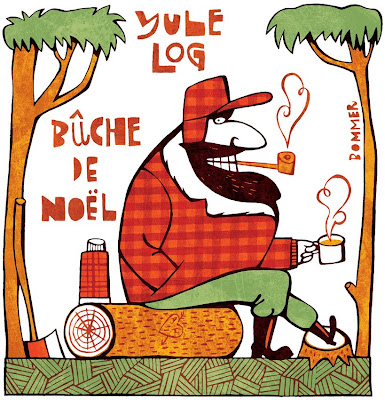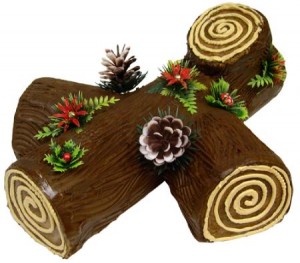Benvenuti nel Calendario dell’Avvento 2022 ideato da Terre Celtiche Blog su ispirazione del Calendario dell’Avvento illustrato da Paul Bommer[1]
Welcome to the Advent Calendar 2022 created by Terre Celtiche Blog from the Advent Calendar of the artist Paul Bommer.
♬
Deck the Hall
Welcome Yule
Banquet Hall (Loreena McKennitt)
15 dicembre:

Un muscoloso taglialegna (Quebecois lumberjack) si sta godendo la meritata pausa dopo aver abbattuto un albero e averlo sfrondato. E’ seduto sul ceppo che porterà nella sua casetta di legno ai margini della foresta in Canada e che brucerà nel suo caminetto durante il Natale. Indossa una corto giaccone di lana a quadri rosso e arancio[2], foderato in pelliccia con i risvolti al collo, un modello vintage tipico degli anni 70 con i pantaloni infilati negli scarponi da lavoro. Paul Bommer ci assicura che quello che c’è nella tazza è tè caldo appena versato dal thermos!
Yule
Di origine germanica ma diffusasi presto anche nelle Terre Celtiche YULE era la festa del fuoco e della luce che si celebrava durante il Solstizio d’Inverno per aiutare il sole nella sua lotta contro le forze dell’oscurità. Una festa dell’allegria e della gioia, di canti e danze, di banchetti e di colossali bevute per “fare il giorno di notte” ossia per portare luce e calore nel cuore gelido dell’Inverno.[3]
Si decorava la casa con rami di vischio e di agrifoglio (il nostro albero di Natale arriva da questa tradizione) simboli del perdurare della vita vegetale (e la sua fertilità) anche nel periodo più freddo e buio dell’anno.
[English translation]
Of Germanic origin but soon spread also in the Celtic Lands YULE was the festival of fire and light that was celebrated during the Winter Solstice to help the sun in its fight against the forces of darkness. A celebration of joy, of songs and dances, of banquets and colossal drinks “to do the day in the night“, that is to bring light and warmth to the icy heart of Winter.[3]
The house was decorated with branches of mistletoe and holly (our Christmas tree comes from this tradition) symbols of the persistence of plant life (and its fertility) even in the coldest and darkest of the year.
YULE LOG
Un grosso tronco (il ceppo di Yule ) era preparato alla vigilia della festa seguendo dei precisi cerimoniali, decorato con nastri e sempreverdi (a volte bagnato con del sidro come offerta allo spirito dell’albero) era portato in casa con canti e benedizioni, per essere sistemato sul focolare.
Passato nella tradizione del Natale, il ceppo era sistemato nel camino del salone alla vigilia di Natale e si manteneva acceso fino a Capodanno o all’Epifania: quel ceppo proteggeva la casa dagli incantesimi delle forze maligne; le ceneri erano sparse sopra i campi per renderli fertili. I resti del ceppo, venivano anche conservati per poter poi alimentare il fuoco che avrebbe arso il ceppo dell’anno seguente.
A large trunk (Yule log) was prepared on the eve, following precise ceremonials, decorated with ribbons and evergreens (sometimes wet with cider as an offering to the spirit of the tree) it was brought into the house with songs and blessings, be placed on the hearth.
Passed in the tradition of Christmas, the Yule log was placed in the fireplace of the main hall on Christmas Eve and was kept on until New Year or Epiphany: it protected the house from the spells of evil forces; its ashes were scattered over the fields to make them fertile.
Some part of it were stored in order to then feed the fire of the following year.

Ai nostri giorni con camini e stufe troppo piccoli per il ceppo di Yule chi volesse celebrare la festa secondo le vecchie tradizioni, potrebbe decorare un tronchetto con candele, sempreverdi, pigne e bacche recuperate in giardino e trasformarlo in un bel centro tavola che illumini le cene della festività natalizia.
In our days with chimneys and stoves too small for the Yule log, those who want to celebrate according to the old traditions, could decorate a branch with candles, evergreens, pine cones and berries as a nice centerpiece that illuminates the dinners of the Christmas holidays.

Bûche de Noël
Il Bûche de Noël (in italiano Tronchetto di Natale) è il dolce tipico della tradizione natalizia francese. La ricetta è semplice e anche la preparazione non è poi così complicata, si tratta di cuocere un impasto soffice tipo pan di spagna in una teglia rettangolare e di arrotolarlo quando è ancora caldo. Una volta raffreddato e srotolato con delicatezza mantiene la sua “piega” e si farcisce con crema a piacere, si arrotola stretto e riveste con glassa al cioccolato decorando la superficie come se si trattasse di un tronco di legno. In rete ci sono veramente tante ricette che non c’è che l’imbarazzo della scelta!
Per la farcitura nella versione in bianco, panna montata con o senza mascarpone (e scorza di limone) e scaglie di cocco per decorare
per ottenere una pasta biscotto più elastica alcuni aggiungono 70 gr di olio di girasole lasciano riposare fino a raffreddamento e poi arrotolano
Deck the halls it’s Yuletide (The Blazing Yule)
La melodia è gallese detta “Nos Galan” e richiama la musica rinascimentale al tempo dei Tudors, il testo invece è più recente e risale al 1800, pubblicato in “Welsh Melodies with Welsh and English Poetry” 1862 con una traduzione in inglese di Thomas Olipahnt che però non rispecchia il significato originale.[5] Un testo simile è stato pubblicato nel 1881 in America (J. P. McCaskey, “Franklin Square Song Collection”). E in effetti è considerato un canto natalizio tradizionale americano.
La prima stesura conosciuta è dell’arpista Edward Jones (in “Musical and Poetical Relicks of the Welsh” – 1784 e successiva edizione 1794), che riporta la melodia con una canzone d’amore; era probabilmente una musica da danzare con l’arpista al centro del girotondo dei ballerini (carola medievale). Il brano è arricchito da molte varianti testuali, ma nella sua versione più antica riporta molte espressioni ormai desuete nell’inglese, e soprattutto, fa riferimento alla celebrazione della antica festa solstiziale di Yule.
A Welsh tune called “Nos Galan” that recalls the renaissance music at the Tudors, the text is more recent and dates back to 1800, published in “Welsh Melodies with Welsh and English Poetry” 1862 with an English translation by Thomas Olipahnt, but that does not reflect the original meaning.[5] A similar text was also published in America in 1881 (J. P. McCaskey, “Franklin Square Song Collection”). And indeed it is considered a traditional American Christmas carol.
The first known draft is by Edward Jones (in “Musical and Poetical Relics of the Welsh” – 1784 and subsequent edition 1794), which he fits the melody with a love song; it was probably a dance music with the harpist at the center of the dancers’ circle (medieval carola). The song is enriched by many textual variations, but in its oldest version it contains many expressions now obsolete, in English, and above all, refers to the celebration of the ancient solstice festival of Yule.
traduzione italiana
Adorniamo le sale con rami di agrifoglio
Tra la la la la..
È la stagione per essere gioiosi.
Fa la la la la, la la la la.
Indossiamo i nostri abiti festosi,
per cantare i vecchi inni del Solstizio.
Guardiamo lo Yule bruciare davanti a noi
suoniamo l’arpa e uniamoci al coro.
Seguitemi con ritmo vivace
mentre vi rivelo dello Yule il tesoro.
Veloce il vecchio anno è passato,
salutiamo il nuovo, forza ragazzi e ragazze,
cantiamo insieme con gioia
senza curarci del vento e del (mal)tempo.
(1) [contrazione di “do on” usata nei testi del 1300: sta per “put on”]
(2) [il temine gay proprio del linguaggio medievale sta per “full of joy or mirth”, la sua connotazione negativa e promiscua risale invece al 1600]
(3) [troll sta per “to sing in a full, rolling voice” cantare forte o con coraggio]
(4) [yuletide: tide usato come suffisso ”point or portion of time, due time”]
(5) [carol: nel medioevo la carola era una danza in cerchio eseguita sul canto di un solista e con un ritornello intonato dal coro, dal 1500 prende il significato di inno di Natale. Nel verso successivo è descritta proprio la danza con l’arpista messo al centro del girotondo di coloro che cantavano.]
Versione di T. Oliphant 1862
Deck the halls with boughs of holly,
Fa la la la la, la la la.
‘Tis the season to be jolly,
Fa la la la la, la la la la.
Don (1) we now our gay (2) apparel,
Troll (3) the ancient Yuletide (4) carol (5),
See the blazing Yule before us,
Strike the harp and join the chorus.
Follow me in merry measure,
While I tell of Yuletide treasure
Fast away the old year passes,
Hail the new, ye lads and lasses,
Sing we joyous, all together,
Heedless of the wind and weather
(1) contraction of “do on” used in the texts of 1300: stands for “put on”
(2) gay is a term proper of the medieval language stands for “full of joy or mirth”, its negative and promiscuous connotation dates back to 1600
(3) troll stands for “to sing in a full, rolling voice” to sing loudly or boldly
(4) yuletide: tide used as a suffix “point or portion of time, two time
(5) carol: in the Middle Ages the carola was a circle dance performed on the song of a soloist and with a chorus intoned by the choir, from 1500 it takes the meaning of Christmas anthem. In the next verse is described precisely the dance with the harpist put in the center of the circle of those who sang.
La versione italiana da cantare con i bambini:
Metti l’agrifoglio in casa questo è un giorno pien di gioia
Metti l’abito di festa canta l’inno del Natale.
L’anno vecchio sta finendo meraviglie stan nascendo
Tempo bello, tempo brutto, sia felice il mondo tutto.
Il tuo cuore sia più buono metti il lume alla finestra
Questo è il giorno del Signore, canta l’inno del Natale
[1] Traendo ispirazione dal Calendario dell’Avvento di Paul Bommer (disegnato nel 2010) anche in Terre Celtiche Blog per il 2022 faremo il count-down dal 1 dicembre fino al giorno di Natale. L’artista ci ha dato l’autorizzazione a utilizzare le immagini dei suoi bellissimi disegni, così ogni giorno volteremo virtualmente una pagina del Calendario per gustarci una storia, una canzone, del buon vino cotto, un dolcetto.. https://terreceltiche.altervista.org/ritual-chants/#ca
[2] https://en.wikipedia.org/wiki/Mackinaw_cloth
[3] https://terreceltiche.altervista.org/yule-la-festa-del-solstizio-dinverno/
[4] Nel Medioevo i dodici giorni del Natale erano per la nobiltà, occasione di festa con quotidiane cene di gala, musica, danze e tanti canti (con maschere, pantomime e sregolatezze), ma le più sontuose si svolgevano il 25 dicembre il 1 e il 6 di gennaio. E sebbene Enrico VIII avesse fondato la sua Chiesa, mantenne i riti cattolici e le consuetudini del Natale. https://terreceltiche.altervista.org/welcome-yule/
[5] http://www.hymnsandcarolsofchristmas.com/ Hymns_and_Carols/deck_the_hall.htm
http://mudcat.org/thread.cfm?threadid=26223

